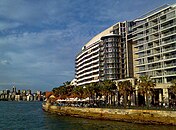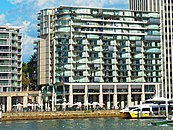Bennelong Apartments

The Bennelong Apartments is a residential apartment building and multi-use complex on the east side of Sydney's Circular Quay. The buildings were designed by Andrew Andersons and PTW Architects, and completed in 1998.
The Bennelong Apartments consist of three buildings. No. 1 Macquarie Street is the northernmost building in the development. It is connected via a bridge at its southern end to the No. 3-7 Macquarie Street building, which houses a cinema, restaurants and shops, as well as apartments. The southernmost building, No. 61 Macquarie Street, contains the Pullman Quay Grand Hotel and apartments. The nickname "the Toaster" derives from the resemblance of No. 1 Macquarie Street to the kitchen appliance, but the term is also applied to the whole complex.
In November 2007, an apartment in the building sold for $8.4 million. With an internal area of 190 square metres, the price of $44,210 per square metre was an Australian record.[1] In July 2015, a Level 11 penthouse in the Bennelong Apartments sold for approximately $22 million, which at the time was the second most expensive apartment sale in the history of Sydney and Australia.[2]
Site history




The Bennelong Apartments sit on the eastern side of Sydney Cove or Circular Quay. This was the site of the first landing by Europeans in Sydney, on 26 January 1788. The governor's temporary canvas house was erected on the east side of the cove.[3] Unlike the southern and western sides of Sydney Cove, the eastern side of the cove remained largely uninhabited in the early years of the colony; one notable inhabitant was Bennelong, after whom the adjacent Bennelong Point and Bennelong Apartments are named. In the early 19th century, the entire area was part of the Governor's Domain, though some commercial activity developed along the shoreline.
During the construction of Circular Quay in 1837-1844, the eastern side of the cove was used as a quarry and housed construction works. After the governor's residence was moved up the hill to the present Government House, in the 1840s and 1850s Macquarie Street was extended north through the Governor's Domain to Fort Macquarie. This led to the development of the area between the street and the shore into a commercial working wharf dominated by the wool trade, while the eastern side of the street remained part of the Domain. This part of Macquarie Street became known as the "wool store" end.[3] Wool and bond stores and warehouses appeared on the site. The historic "Moore Steps" was built in 1868 as a passage between two wool stores, leading from the shore to Macquarie Street.
Major redevelopment of East Circular Quay did not occur until the 1950s. Wool stores were demolished and replaced by a number of modernist commercial buildings lining the eastern side of Circular Quay. The height limit was increased from 150 to 915 feet (46 to 279 m) in 1959.
Between 1971 and 1989, Colonial Mutual Life acquired the buildings along east Circular Quay for a large scale development. The initial, highly controversial design was revised after the intervention of the then Prime Minister Paul Keating. In return for reducing the height of the buildings and adding a colonnade to facilitate public access, the development was permitted to extend further towards the Circular Quay foreshore, with the design finalised in 1992.
Criticism
In 1994 the Anti-Wall Committee was formed to protect the Sydney Opera House from nearby urban development. In 1997 the "Save East Circular Quay Committee" was convened by Tony Rodi and Paul Johnson, and chaired by Neville Gruzman, and later by Jack Mundey in the battle to stop the desecration of the Sydney Opera House Precinct.
"Thousands join fight to save East Circular Quay"
"The desecration of East Circular Quay strikes at the nation's psyche ... Australia's most hated building must go.'" (Sydney architect Mr Tony Rodi, the convener of the Save East Circular Quay Committee, in Totaro P, smh_98.05.16)
http://www.csmonitor.com/1998/0717/071798.feat.feat.11.html/(page)/3
Some commentators are of the view that the design of the building does not enhance the Sydney Harbour foreshore. The building has been criticised for the quality of its design, its occupation of previously public space, and its positioning, and blocking historical sightlines. David Williams describes the Toaster as a "building that most Sydneysiders would quite happily blow up".[4] Lavartus Prodeo developed The Toaster awards for crimes against amenity - a reference to the controversial architecture of the building.[5] One of the project's most vocal critics was broadcaster Alan Jones. Jones would later purchase an apartment in 1 Macquarie Street.[6]
-
No. 1 Macquarie Street, "The Toaster", view from Circular Quay
-
No. 61 Macquarie Street, the Pullman Quay Grand Hotel, view from The Rocks
References
- ^ "'Toaster' flat fetches $8.4m". The Sydney Morning Herald. Fairfax Media. 15 November 2007. Retrieved 22 April 2011.
- ^ Macken, Lucy. "Sam Arnaout revealed as the buyer of the $22 million Toaster penthouse". Domain.
- ^ a b Dictionary of Sydney - East Circular Quay
- ^ David Williams Archived 31 August 2007 at the Wayback Machine
- ^ The Toaster awards for crimes against amenity
- ^ Alan Jones Chronology Four Corners 6 May 2002


